“Data science is something that’s quite interesting to me … and I knew how important it was working in my neck of the woods, but what I didn’t really quite understand was how important it is right now to everything,” said Gilmer, who presented the Clavius Distinguished Lecture at Fordham on Nov. 16—the first held since the COVID-19 pandemic.
“It is really the glue, the binder of nearly every academic department— from English to psychology to biology to the hard sciences. It is opening up profound new venues across the board.”
Held in Lecture Room 3-03 at the Law School, the lecture drew more than 80 students, faculty, and guests. Since 2010, the Clavius Distinguished Lecture Series, has brought scholars, researchers and entrepreneurs to Fordham to share their knowledge with the community and the general public. The series is named after Christopher Clavius, S.J., a 16th-century mathematician and astronomer who helped develop the Gregorian calendar.
Using Data Science in Energy
Gilmer said that data science in the oil and gas industries is used to help predict what types of rocks are under the surface, locate where oil and gas might be found, prescribe how to frack a well for the best return and lowest environmental impact, track supply and demand, and predict future needs and prices.
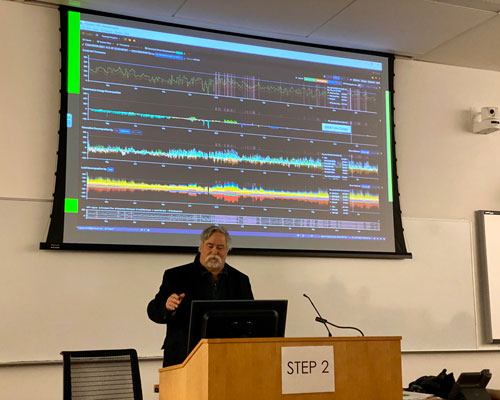
Gilmer gave some examples of how utilizing data analytics can make a company more efficient and effective. For example, data analytics can help a company learn how to frack oil and gas with the least amount of wells into the ground.
“How do you go out there and do it with a minimum number of well bores on the surface because you have a surface impact when you’re doing any of these things, and then also trying to figure out how you’re going to keep your aquifers safe—those are all pieces in the dynamics of this project,” he said.
Utilizing informatics can also help a company operate more efficiently, Gilmer said. His software company does a lot of work in seismics—exploring below the ground to find rocks that produce oil and gas.
“In this case, [our machine]was looking for discontinuity—discontinuity in these waveforms—it was going out there and it was a way of being able to very quickly identify fault patterns [in the Earth],” he said. “The machine went out there to find the faults—this would have taken a geologist a month to figure all this stuff out.”
With that data, they were able to see how production was impacted by faults.
“You can see that the closer you were to a fault, the less production you were making,” he said.
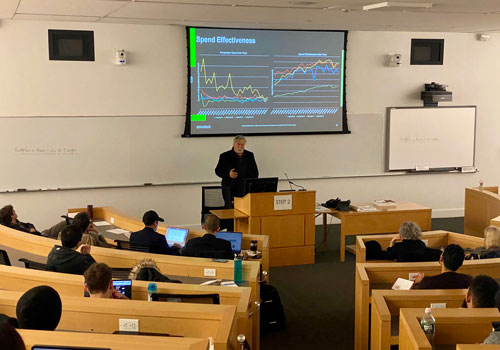
He also highlighted how informatics can be used to track and improve upon the environmental impact of a project.
Still, Gilmer told the students that while data was essential, they should use it to address bigger problems, not get stuck in the details.
“Whether you’re a physicist, a chemist, a geologist, or what have you—you should not look at your job as being a series of formulas,” he said. “You should be thinking about how to address real problems and how to think about them.” This, he said, is “where greatness comes from.”
In addition to sharing information about data science at lectures like this one, Gilmer—who was named an EY Entrepreneur of the Year in Texas in 2012—is also committed to helping others learn more about it. He established the data analytics program at the University of Texas El Paso, with D. Frank Hsu, Ph.D., the Clavius Distinguished Professor of Science at Fordham, who also attended UTEP.
“If you don’t have the interest in doing it yourself, become good friends with somebody who’s really good at this stuff, because sometime during your lifetime, sometime in the next five or 10 years, you’re going to have a big need or a big use for these skill sets,” he said.
From Fracking to Film
While Gilmer’s background is as a geoscientist who worked in energy, he’s also had a passion for film, calling it “one of the best ways of storytelling.” He’s a managing partner of Redbud Studios and AHuevo Films, which produces and finances feature films and streaming content. Their upcoming film Alina of Cuba, starring James Franco and Ana Villafane, has made headlines as it tells the story of Fidel Castro’s daughter and her defection from Cuba.
Gilmer said he’s tried to also incorporate analytics into his film company’s work.
“We’ve been producing films for the last few years, and I’ve been trying to figure out how to do it in a smarter way,” he said. “It’s an industry that does not have a lot of good data, it doesn’t have easy access to [the data]—it is a closed-off system. It’s a very difficult business environment in which to go out there and make wise decisions.”
They’ve had to get creative to gather feedback from their audience, such as pushing out requests for Amazon reviews on social media.
“It’s really a business of building up a lot of different proxies with regards to figuring out how any of these things are going to work,” he said.
Hsu said that this was one of the best talks he’s heard, particularly in terms of the variety of topics discussed. He also joked that Gilmer—or one of his students—had their next task laid out for them: “Create a new field of movie informatics.”
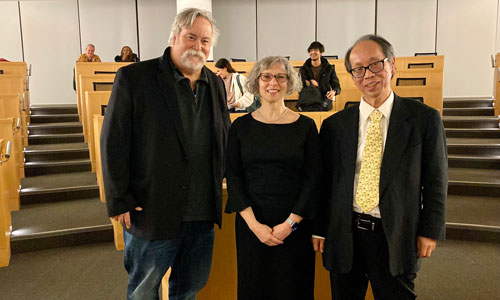
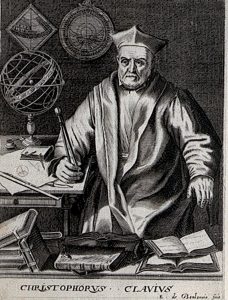
Titled, “Comets, Craters, and Calendars,” the lecture celebrated the 480th anniversary of the birth of the great mathematician and astronomer Christopher Clavius, S.J. Father Mueller is the vice director of the Vatican Observatory and superior to its Jesuit communities in Rome and Arizona. Following the talk, a panel of Fordham mathematicians and scientists shared how Clavius influenced their lives and work.
Champion of Mathematics
For the lecture, Father Mueller took listeners on a tour through the history of a man who, among his many accomplishments, is perhaps most noted for championing and helping design the Gregorian calendar that is still in use today. But the calendar, famous as it may be, was not the primary focus of Father Mueller’s talk. Instead he equated the scene from 2001 to Clavius’ championing of mathematics.
“In my view, Clavius played a historical role somewhat akin to that of Kubrik’s monolith: Through his teaching and textbooks and curricular reform, Clavius was the midwife of one of humanity’s great leaps forward: the scientific revolution,” he said.
Father Mueller was careful to point out that Clavius, who was born in Bamberg, Germany, may not have played an “active first-person role in the scientific revolution of the first half of the 17th century,” as he died in 1612. But through his many years of teaching at the Jesuit Roman College and through the wide use of his textbooks on mathematics and astronomy, Clavius greatly influenced the innovators and discoverers. He also “amplified” the importance of mathematics at universities, Father Mueller said, which theretofore had been taught at the 16th-century equivalence of high-school level.
“In the 16th-century curriculum, mathematics did not have the high status of a science,” he said. “A science was understood to be a discipline capable of knowledge of true causes. Mathematics was held to deal not in true causes but in mere abstractions—in mere possibility rather than reality. Mathematics teachers and faculty members were seen as being of lower status—they didn’t have much of a say.”
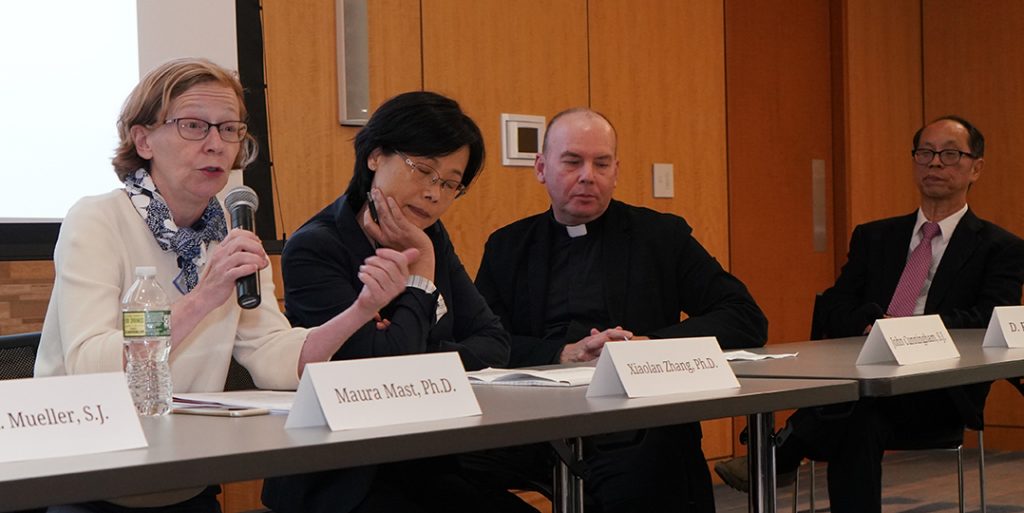
Forming a Pedagogy
Having joined the Jesuits in 1555, Clavius was received into the order by St. Ignatius himself, placing him amidst the “explosive growth” of the young order and its ever-expanding roster of Jesuit schools. Near the time of Clavius’ death there were 372 Jesuit schools that would have been the equivalent of junior colleges today. Even outside of the Jesuit institutions, from the 1580s to the 1640s “just about everyone got their introduction to math and astronomy from textbooks written by Clavius,” said Father Mueller.
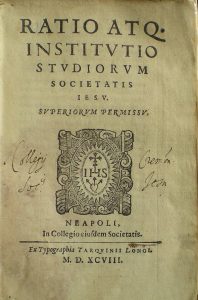
Father Mueller noted a few examples of Clavius’ fame, which he cemented through his role as the official public explainer and defender of the calendar. As a young professor, Galileo relied on lecture notes obtained from Clavius’ math and astronomy class, which led him to conclude Clavius “worthy of immortal fame.” During Clavius’ own lifetime he was known as “the Euclid of our Time.” And at St. Peter’s Basilica in Rome, there are only two Jesuits who are portrayed: St. Ignatius of Loyola and Clavius, who can be found on the tomb of Pope Gregory XIII, presenting the new calendar.
In Part VI of his Constitutions for the Society of Jesus, St. Ignatius called for a separate document to provide guidance for Jesuits schools. That “separate treatise” eventually became the famous Ratio studiorum of 1599, and Clavius held significant sway in its treatment of mathematics, said Father Mueller.
“An earlier 1591 draft of the Ratio includes an admonition to university administrators to make sure that philosophy teachers do not disparage the dignity of mathematics,” he said. “In a document written as a contribution to preparing the Ratio, Clavius wrote: ‘Since … the mathematical disciplines in fact require, delight in, and honor truth… there can be no doubt that they must be conceded the first place among all the other sciences.’”
Post-Lecture Q&A
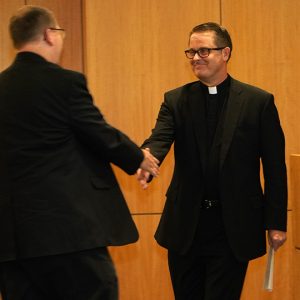
Father Mueller said that both the new Gregorian calendar and Clavius’ proposals for an augmented role for mathematics in the curriculum met with significant resistance, and in both cases Clavius took on a “prominent role as explainer and defender”—of the “validity of the calendar and of the dignity and worth of mathematics as a path to objective truth.” It’s a role that resonates to this day, with science and truth under attack at the highest levels of government and religion. In a conversation after the lecture, Father Mueller drew parallels between Clavius’ role and that of contemporary Jesuit institutions.
In your talk, you noted that at the time of his death Clavius had not finished publishing his theory of astronomy. It sounds like he was very cautious with the truth.
At the end of his life, he mentions in a letter to one of his colleagues that he’s in the middle of writing a theory of astronomy, but he also mentions explicitly that he’s waiting for more data from [Danish astronomer] Tycho Brahe, to help him know what he wants to do. He never ended up publishing it in his lifetime. I personally think what happened was he saw that astronomy was changing so rapidly, the time was not right to write a theory.
Last spring’s Clavius lecture dealt with artificial intelligence. Things are moving so quickly in that sphere that peer-reviewed articles are almost an impossibility. What would Clavius make of that?
Be careful about imposing the whole notion of peer review back on him. His time is where the whole idea that empirical observation of the heavens can affect astronomical theory. That itself is a new idea. You knew your astronomical theories from ancient authorities. That’s part of what got Galileo in trouble, but I think Clavius was doing it more cautiously. The whole thing with Galileo blew up after Clavius died, so he had no notion that there was theological danger. But, I think, as a teacher, he didn’t want to go in print with a textbook with stuff that’s not right. In the late 1500s there was an extraordinary series of comets and novas in the heavens, which really wowed people because physics at the time said that the heavens should be immutable and unchanging. Clavius participated in proving this stuff shouldn’t be changing. So, I think that’s part of what slowed him down. He says at one point, ‘Maybe we need to rethink at a fundamental level, our astronomy.’ Today, we all agree what the standards are. Clavius was in a time when the very notion of standards themselves were changing.
Clavius had the ability to speak to the public and the men in power to convince them of truth and the importance of empirical standards. What lesson we can draw from that today?
Clavius had to explain and defend. I hope I don’t sound too despairing here, but he lived in a time when everyone knew and believed that there was such a thing as an objective truth. They might have disagreed about how to get there, the standards were changing, but no one disagreed that there is objective truth. We are now in a very strange time, a new time, where for many reasons, people’s confidence in the very notion of objective truth has been shaken. And, I find that to be a really dangerous and a sad step backwards. … I’m very discouraged by the fact that, as a culture, we seem to be backing away from the notion that we’re capable of coming to agreement on objective truth. It’s hard, you’ve got to work at it, you’ve got to be willing to fight, but there’s a truth out there.
Yet so much of the recent challenges to science come from people of faith. How do you, as a Jesuit, deepen your faith in light of scientific truths?
My colleague at the observatory, Guy Consolmagno [S.J.], is always clear in saying that when he does science, for him it’s an act of worship. If God is the way, the truth, and the life, then when you look for the truth via science, you are also looking for God. I believe that the very search for truth means that I trust that my reason participates in God’s reason. I’m made in God’s image and I really think that matters. We really need to work together to come to some kind of agreement on these things, because it’s a great, lovely mystery that should bring us together.
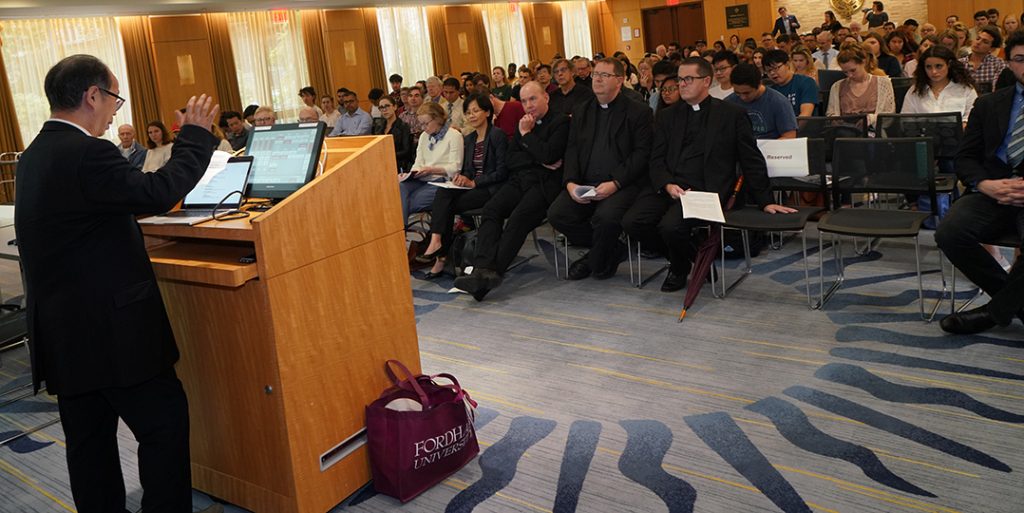
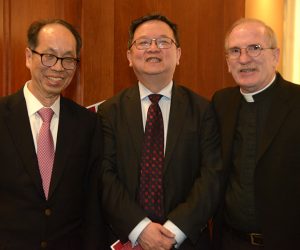
Guo provided some examples by describing the work of his lab. The lab is organized in several sectors, starting with the Hub, which deals with machine learning and data management and analysis. The Hub anchors other labs, including those focused on data economy, business analytics, data assimilation, computational privacy, social and cultural analytics, and behavior.
Reading the Brain’s Reactions
Often the lab’s work combines two of these sectors. For example, Guo said, the machine methodology of the Hub can overlap with behavior analytics. Together, the two could hold the potential to explain the effects of advertising on a variety of individuals by distinguishing brain reactions based on sex, race, age, economic bracket, and even lifestyle. Subjects cab be wired to an EEG machine to measure brain activity while another machine measures eye movement.
“We want to look at the correlation between the two signals; one is measured on the brain wave and the other is on the eye movement and we translate one signal to the other,” said Guo.
The data can not only measure interest in a particular ad, but also precisely what part of a commercial the subject was looking at when that interest peaked.
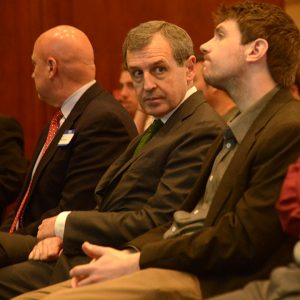
Potential Heath Care Benefits
It’s also easy to imagine health care applications, Guo said. Doctors can compare their patients’ EEG data against the profiles of thousands of participants, while including specific details beyond just the eye movements, such as a person’s gait and other muscle movements.
When the data sets are compared, anomalies readily reveal themselves. This information can have practical diagnostic applications for everything from Parkinson’s disease to sports medicine and neuroprosthetics.
A View into Dreams
This meshing of data, together with a person’s body movements, can literally reveal to scientists what is going on in your head.
“If I point, that involves a sequence of activities and those activities constitute a language, a sentence, a grammar,” Guo said. “So, what you can do is align those sentences with a brain activity.”
Then, from viewing maps of brain activity, scientists can tell which type of motion or gesture a person might be carrying out in their thoughts or dreams.
“The implication is that at night when you’re asleep, from inside our machine I can pretty much know what your dream is all about,” he said. “That’s pretty scary, but that’s the research.”
With such a level of intimacy exposed, Guo said scientists must maintain strict ethical standards and subjects must be fully aware of the implications before agreeing to participate in a study.
For more on big data and artificial intelligence, watch the entire lecture below.
]]>However, if the computer and information science field focuses too narrowly on producing the next best gadget rather than improving technology already in use, the cost could be our safety and wellbeing, cautioned Marios Polycarpou, PhD at Fordham’s 2015 Clavius Distinguished Lecture.
In an April 17 talk on “Intelligent Big-Data Monitoring of Critical Infrastructure Systems,” Polycarpou stressed preempting catastrophic technological failure by focusing on making our smart devices smarter.
This is especially important for technology that underlies our critical infrastructure systems (CIS)—such as power and energy systems, telecommunication networks, transportation systems, and water networks.
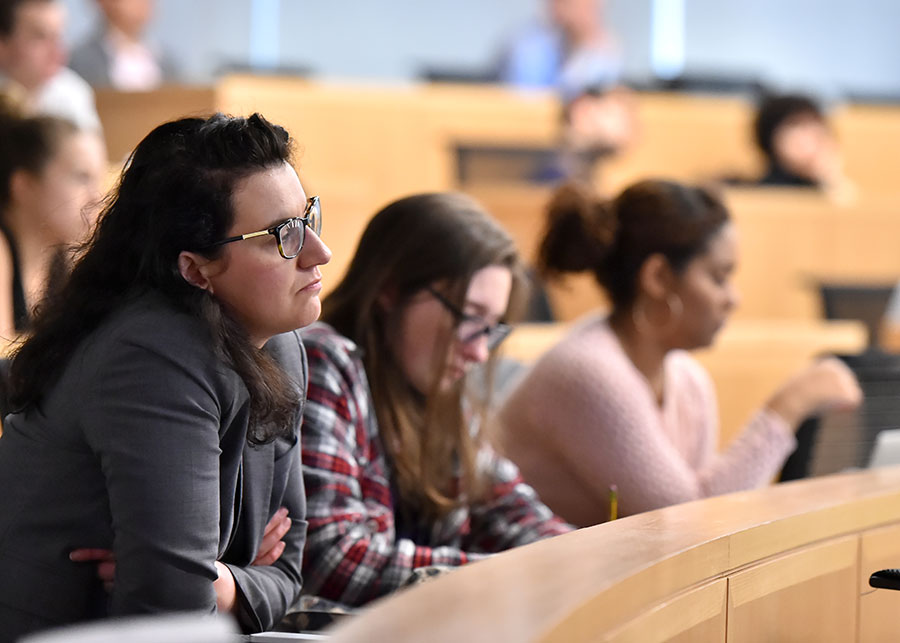
“These systems are critical for everyday life and well-being, and people expect them to always be available. But the problem is that they do fail. And when they fail, the consequences are tremendous,” said Polycarpou, a professor of electrical and computer engineering and the director of the KIOS Research Center for Intelligent Systems and Networks at the University of Cyprus.
To prevent natural disasters, equipment failures, or malicious attacks leading to catastrophe, he said, “we need to design smarter infrastructure networks. This means designing smarter software to handle any faulty hardware.”
Smart technology is the next logical step following the “sensor revolution” of the 2000s, Polycarpou said. The introduction of sensors gave technological devices physical capabilities akin to the traditional human senses—balance, pressure, and temperature as well as sight, hearing, smell, and touch.
Now that these gadgets can sense their environments, they need the ability to process the information they gather and make decisions in response—which is the essence of smart technology.
“These devices have sensors that provide information and a brain that processes that information,” Polycarpou said. “They’re not just passive devices that make tasks easier for us, but have intelligent software to … make decisions.”
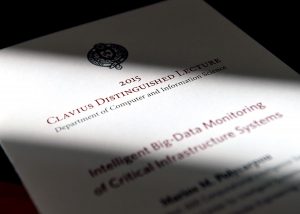
The growth in global population (Polycarpou cited that in 2000 there were 18 megacities around the world, whereas there will be an estimated 30 megacities by 2020 and 60 by 2050) makes CIS intelligence even more important, as most infrastructure networks are intertwined.
“If there’s an earthquake and everyone tries to use their phones, the communication system could break down,” he said. “There’s a lot of interdependence. When something goes wrong, it can propagate through the other infrastructures.”
The annual Clavius lecture and the Clavius Distinguished Professorship of Science, which is held by D. Frank Hsu, PhD, honors 16th-century mathematician Christopher Clavius, SJ, who helped develop the Gregorian calendar and was an early advocate of Galileo’s heliocentric model of the universe.
]]>
It’s not frequent that artists are invited to join scientists, engineers, and social scientists for a lecture on cognitive neuroscience. But this year’s Clavius Distinguished Lecture held on March 27 featured Shinsuke Shimojo, Ph.D., whose exploration of vision, perception, and decision-making piqued everyone’s curiosity.
“This talk [is]of interest to a wide range of people, not just scientists,” said Shimojo, the California Institute of Technology Gertrude Baltimore Professor of Experimental Psychology.
Titled “Sensory Substitution, Multisensory Plasticity, and the Third Kind of ‘Qualia,’” Shimojo focused on qualia, which, to some, refers to the absolute, unique quality of a conscious sensory experience–i.e., when two people look at a saturated color are they seeing the same thing? Or do they each see it in their own unique manner? Since qualia is not something easily defined through words alone, Shimojo incorporated plenty of sound and visual examples.
Shimojo said qualia presents a conundrum for scientists, since its not a “hard” problem. Nevertheless, current sensory sciences fail to critically characterize the unique quality of sensory experiences.
As an example, Shimojo has examined a sensory substation device used by the blind called a “vOICe.” Operating like a scanner or radar, vOICe uses a portable computer and digital glasses to translate video data into a sound stream. Contrasts are translated into pitch and volume, allowing dimension and distance to come into focus.
“We are trying to give the blind some digital ability, but in order to do that you need to rely on the brains ability to learn how to interpret the sound,” said Shimojo.
Shimojo brought a short video of colorblind artist Neil Harbisson, who collaborated with an engineer to create a device that translates color into sound. The artist claims that he can now “see” color.
“Inspired by this, we studied aesthetic experience though devices and now we have neuroaesthetic data about people’s judgment,” said Shimojo.
Shimojo explained that if calculations can be derived to translate the visual into sound, then an inverse calculation could be made from sound to the visual.
Below, Harbisson explains how he is taking a similar approach by creating a clothing line where the colors are dictated by songs.
“You can go to a funeral wearing a “Requiem” from Mozart. It will look very colorful, but it’ll sound very sad,” he said.
And while much of Harbisson’s approach to the science sounds amusing, it holds very serious implications. Some of the blind subjects using the technology have shown activity in the visual cortical areas in fMRI scans. Shimojo said the ultimate strategy is to come up with a brief list of psychophysical and neuroscientific criteria for “vision-like” processing and to search for empirical evidence.
“You don’t have to be blind to appreciate the technology,” said Shimojo. “Through calculation and translation, from well-known painting to classical music, by using these devices we can add another dimension of our sensory experience.”
The lecture took place on Thursday, March 27, in the Flom Auditorium in the Walsh Library at Fordham’s Rose Hill Campus.
For more Information, contact Palma Hutter at [email protected] or 718-817-4480.
]]>